Follow Spencer Schubert on his adventures into remote corners of the Dominican Republic and learn how birds (and their poop!) naturally restore forests. And they do this for free!
Bird enthusiasts have long struggled with the challenge of attracting birds to their backyards, often employing the use of feeders, bird baths, or populating their gardens with plants that birds like. There’s something about birds that really captures our attention, whether it’s their impressive bright plumage or the cheery music they produce.
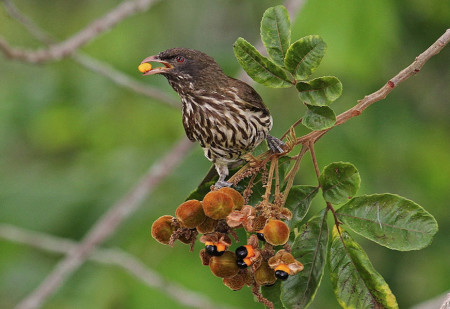
But birds have a lot more to offer beyond aesthetics. With an estimated 10,000 species of birds inhabiting our planet, it is perhaps unsurprising that they have adapted to eat just about any type of food found in nature. As it turns out, birds’ choice in cuisine often turns out to be beneficial to environments where humans live. Scavenging vultures limit the spread of pathogens by consuming dead animals. Birds of prey control rodent pests. And many birds feed on insects that can be damaging to farmers’ crops.
Another ecosystem service that fewer people are aware of is the dispersal of seeds in bird feces. That’s right! I am talking about bird poop. But before we all get too excited about bird poop, I need to take a few steps back to properly explain what I mean by this…
Many different kinds of birds have a sweet tooth for the juicy, nutritious fruits of the forest. But do yourself a favor and resist the temptation to try strange fruits that you see birds eating. Many of these are unpleasant and even toxic to people. Our palates are very different from those of birds, and that is no coincidence. Birds have evolved over time in native ecosystems with their plant neighbors, and many plants have adapted to take advantage of birds in a remarkably clever way.
You see, plants are faced with a different set of problems than those facing animals. Most importantly, they can’t really move around. For example, a tree cannot choose where it ends up and where it takes root. Long-lived trees might produce thousands, if not millions of seeds over their lifetime. Most of these fall to the ground directly below their parent, where they either get snatched by insect or rodent predators, fail to germinate, or eventually succumb to the overbearing shadow of their parent. (And you thought your parents were oppressive!).
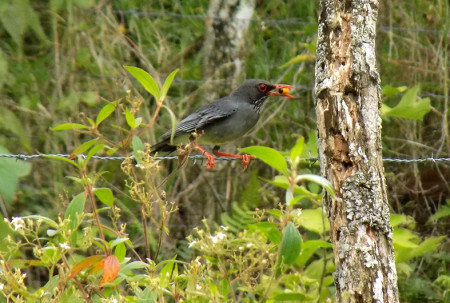
Some lucky seeds manage to venture away, taking a ride with the wind, through the water, or undamaged in an animal’s gut. Some of these lucky seeds get even luckier still, by landing safely in a nice patch of fertile soil and substrate with moderate lighting from a gap in the forest canopy above.
Birds’ ability to fly long distances and visit a variety of habitats in a relatively short period of time makes them great seed dispersers from the perspective of the plant, and these two groups have evolved a mutualism for which they depend on the other. In exchange for their seed-dispersing services, birds are rewarded with a food supply.
Can a seed, dispersed, create a forest?
For my current research, I am working in the Dominican Republic, where I am trying to collect data to understand how seed dispersal by birds in cattle farms might be important for future forest restoration efforts in the region. Human populations all over the world are ravenous for beef and dairy. And in the tropics, by many estimates, the clearing of forests for livestock grazing lands has historically been the leading cause of deforestation. As a result, many experts see forest restoration in abandoned pastures as a key conservation strategy both in the present and in the future.
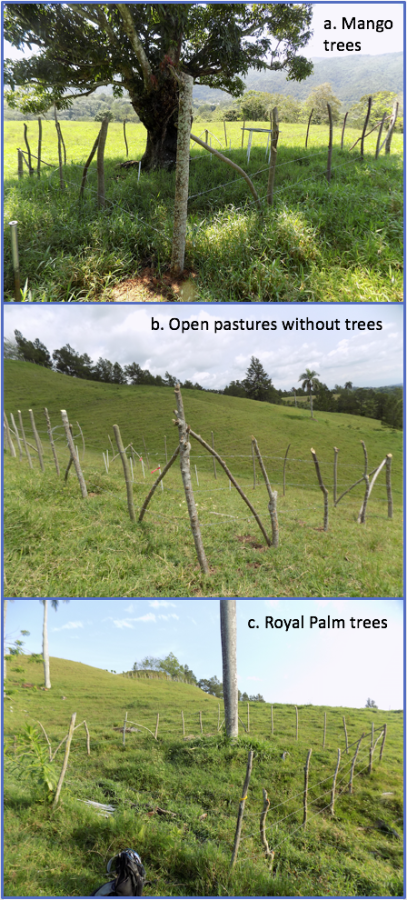
Having said that, restoration projects are expensive. The costs associated with growing trees in a nursery, transporting them, and caring for them after transplantation are high. It can conceivably cost thousands of dollars to manually reforest an area the size of a basketball court. In regions such as our work site in the Dominican Republic, where economic conditions are such that most working class jobs only pay $10 to $20 dollars per day, it is very difficult to convince organizations to take on these expensive projects.
The first step to my research project began about 18 months ago, when I secured permission to conduct my studies on a single large cattle farm near Jarabacoa, Dominican Republic. The land owner agreed to let me fence off small sections of existing pastures to study seed dispersal and forest regeneration in the absence of human management and grazing, simulating abandoned conditions.
Señor Jose Brache is quite the character. An older gentleman on the verge of retirement, Sr. Brache much prefers his peaceful farm over the hustle and bustle of urban Santo Domingo. Like many older Dominican men, he has a lot to say about just about everything. It has become a frequent occurrence that Sr. Brache will encounter us on the main farm road in his truck and “kidnap” us for a ride to a part of the farm where he will tell a story about what the area looked like when he bought the property more than 20 years ago.
The first part of my project has been to study how certain isolated trees can attract birds to venture away from the forests out into the open pasture and how this might result in increased seed dispersal by birds and forest regrowth. Some of these selected trees included colony nest trees of Hispaniolan Woodpeckers and Palmchats, large mango trees, and control plots with no tree.
Perhaps the more interesting finding has been that relatively little forest regeneration has occurred during the study, so far. Below colony trees with many birds attending the tree, for example, both seeds and tiny seedlings are everywhere, but most of them do not survive. While it is still too early in the study to draw major conclusions, there is plenty of evidence to suggest from this and other similar studies that most seedlings end up losing their battle for survival when facing thick, tall grasses that are typical of these pastures. Furthermore, my findings suggest that it’s not so important how many seeds arrive as how good the habitat is when they get there.
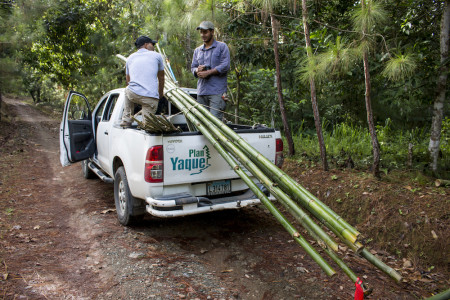
While isolated trees in pastures are not the miracle cure for deforestation that I would have hoped for, even a small effect is potentially valuable, especially when it’s FREE. These findings rattled my brain… the presence of trees as perches for birds potentially begets more trees and biodiversity. So rather than waiting decades to grow a nice tree that birds will use and disperse seeds around, I thought of a shortcut… Artificial perches.
An artificial perch is exactly what it sounds like: any man made object or structure that birds can perch on. From my reviews of scientific literature, I soon learned that this is not a new idea. A handful of studies dating back to the late 90s have attempted various designs for artificial perches to study how birds use them and contribute to seed dispersal and forest regrowth. Results have been mixed with some more successful than others. There is still not a clear consensus on the subject, but I knew it was worth a shot. I began looking for larger scale restoration projects that would provide an appropriate context to carry out this work.
A New Collaboration with Plan Yaque
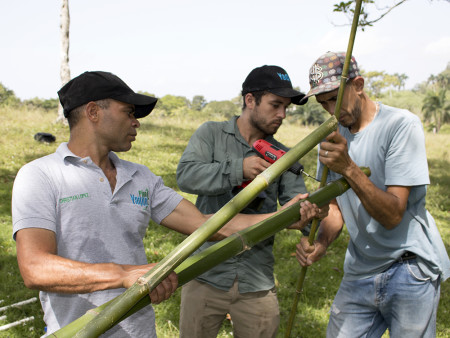
I did not have to wait long for an opportunity. It was June of 2016. Through a local colleague, I learned about a budding wetland restoration project in the town of Jarabacoa where I was working that was to be taken on by the NGO known as Plan Yaque. This organization is responsible for the conservation of natural resources in the Rio Yaque del Norte watershed, working mostly in rural farm communities.
After a few probing emails to the director, I was invited to attend an event with this organization. From the way they described it to me, it was meant to be something of a ceremony or convocation of a new community project they were undertaking. Put simply, Plan Yaque had convinced one of the community leaders in a rural neighborhood called Piedra Blanca to let them install a small dam structure in a stream running through the farm of one of the community leaders. They called this dam “trampa de agua” (water trap), and the premise of this project was to create a small reservoir in a headwater, spring-fed stream to maintain human-usable water sources from going completely dry during droughts.
Another major focus of this project is planting native tree species alongside this stream to help establish riparian forests with the aim of preventing soil erosion and mitigating the contaminants in the environment. They labelled the whole project with a clever title: “Litro de Agua” (Liter of Water) to communicate their objective of providing a consistent source of clean water to keep their farms going.
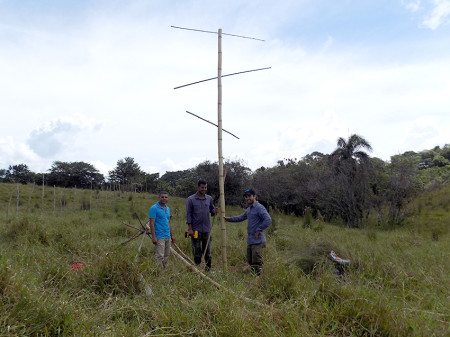
I met up with the director of Plan Yaque and several technicians on a hot June day, and we made our way out to the site riding in flatbed of their pick-up truck along a rural highway through the foothills of the Cordillera Central. Only a day prior, the technicians had finished their makeshift dam, made from a combination of sandbags and old recycled car tires—a clever and low-cost approach for this function. On the near side of the creek, they had enclosed part of the pasture field with a barbed wire fence about 25 meters wide and 60 meters long to keep cattle from disturbing the upper stretch of the stream and their improvised dam construction.
Plan Yaque’s technicians held a short public forum with the family and neighbors explaining the goals of the project and inviting a discussion on how they could improve the project and monitor its success in more meaningful ways. Beforehand, the director had asked that I share my experiences with the farmers and talk about the importance of birds for healthy forests. My Spanish is pretty good. By this point, I had spent a collective eight academic years studying the language and nearly a year’s worth of time working in various Spanish-speaking countries. Dominican farmers don’t see a lot of foreigners, and I could see a lot of curious stares in my direction as I somewhat awkwardly presented, as I now present to you, this idea that birds (and their poop) are protagonists of natural reforestation. If you found my proposition to be a little eccentric, you can imagine how crazy I must have seemed to these people. Nevertheless, I got my message across and it has given my project an opportunity to greatly expand our research efforts.
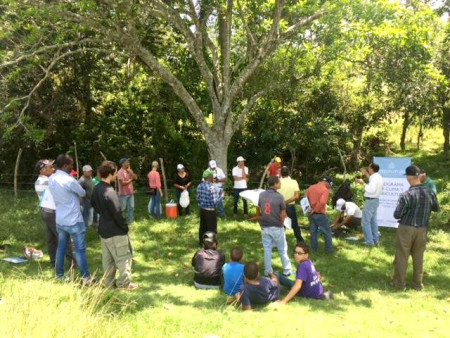
One of the most remarkable discoveries during these adventures, from my point of view, concerns the Dominican people. Some of the most outspoken conservationists I have met in the country come from its most remote corners of the country. I have spoken to dozens of farmers over the age of 70 who tell me stories of lush green forests covering the hills and how so many birds have practically disappeared since their childhood. Fortunately for me, these individuals have graciously received me and my research project into their community. Together with our partner organization Plan Yaque, we are now incorporating both of our agendas into a single project. While they struggle to improve water availably and quality for farmers, I am recruiting the birds to bring the forest back and restore at least a piece of the glory that was once the tropical forests of Jarabacoa.
With the support of my university, funders, my partner organizations, and local farmers, we have started up a new project to study this untapped potential of fruit-eating birds. Currently our team is halfway complete in our goal of constructing eight plots for the calendar year. We will continue to study these plots over the course of two years with the goal of turning the project over to our local partners and arming them with new cost-effective, bird-friendly techniques for forest restoration.
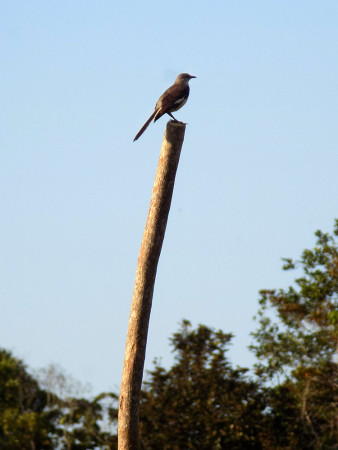
I owe thanks to a handful of individuals and organizations for their role in making my project so successful. Devoted efforts from project technician Joaris Samuel Gonzalez and field assistants Alex Lascher-Posner, Paris Werner, Kim Shoback, and Tyler Glaser helped get this study off the ground and were invaluable for data collection. Dr. Eric L. Walters of Old Dominion University helped advise the project and has been instrumental in the progression of my ideas and my development as a scientist. My fiancé, Holly Garrod, has helped me hold my life together during graduate school and has also contributed substantially to my research project as she pursues her own graduate research in the Dominican Republic. Local organizations Plan Yaque and Rancho Baiguate have provided key logistic support, without which this work would not have been possible. Furthermore, numerous private land owners have generously received us on their farms to conduct our field studies. This research was funded jointly by the Rufford Small Grant (II) Program, the Sophie Danforth Conservation Award from Roger Williams Park Zoo, and the David S. Lee Fund Grant from BirdsCaribbean.
By Spencer Schubert. Spencer is PhD student in the ecology program at Old Dominion whose thesis focuses on the contributions of avian seed dispersal to tropical forest recovery and plant-frugivore seed dispersal networks on farmland landscapes in the Dominican Republic. Spencer was a recipient of the 2016-2017 BirdsCaribbean David S. Lee Fund Grant and is using his research as a platform to raise interest in the ecological importance of birds for restoration projects in the region around Jarabacoa.
Another follow-up article on Spencer’s research:
